
GINZA CONNECTIVE
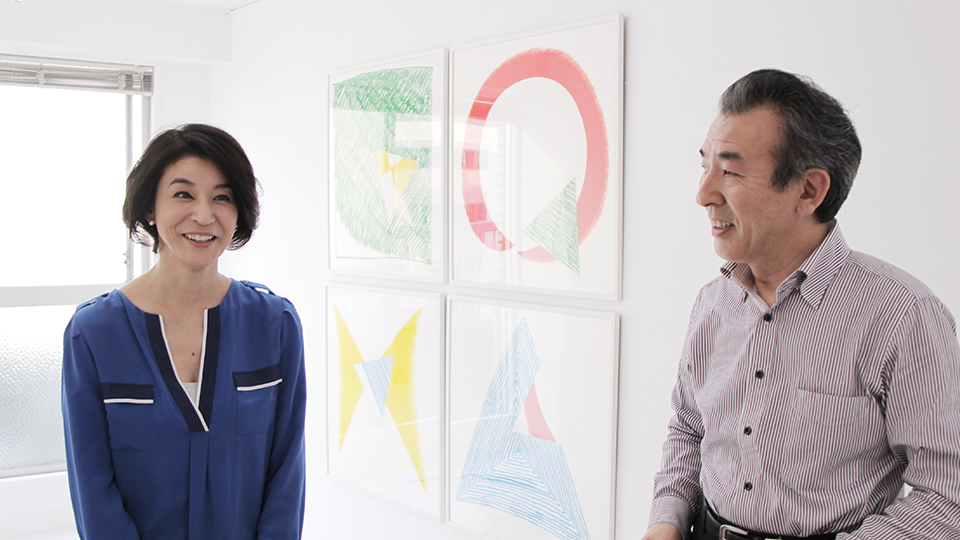
GINZA CONNECTIVE VOL.19
Hozu Yamamoto×Chisako Takashima
2013.04.01
A talk series with the violinist Chisako Takashima and the Ginza people. Ginza holds many personal and professional memories for Takashima. In this talk series, she thoroughly explores various aspects of the Ginza culture with her guests. Today’s guest is Hozu Yamamoto, president of Tokyo Gallery, Japan’s first modern art gallery.
During my childhood I was surrounded by artists.
- Takashima
- Was it your father that first opened the gallery?
- Yamamoto
- Yes. My father opened the Tokyo Gallery in Ginza in 1950 and initially hung Western-style paintings by artists like Tsuguharu Fujita and Soutarou Yasui who studied in Paris. Later, at the very end of the 50’s, he went to Paris himself. At that time, there was a major abstract impressionist movement going on called Art Informel. My father returned to Japan confident that the rest of the 20th century would be devoted to abstract art. After coming home, he decided to focus on abstract paintings in Japan, and introduced the latest European pieces in the gallery. Lots of young artists and even Issei Miyake in his student years started coming around.
- Takashima
- No kidding! Did your father originally work in the art world?
- Yamamoto
- He came from a poor family, so he started an apprenticeship at an antiques shop immediately after higher elementary school. Then he went to fight in the war. The war was followed by the dissolution of the Zaibatsu (financial combine), and a period when a new population of rich people emerged. My father started working as a mediator for selling paintings from the previous rich people to the new rich people.
- Takashima
- He must have been a connoisseur. Did he also deal in antiques?
- Yamamoto
- No, he didn’t. After going independent, he started selling western-style modern art to art museums. He would bring paintings to the Oohara Museum of Art (in Kurashiki City, Okayama Prefecture), collect money, and then go spend it in Kyoto (laughs).
- Takashima
- Really?!
- Yamamoto
- Well, he had the experience of surviving the war, and must have considered himself lucky just to be alive, right? So he probably never thought about accumulating wealth and just wanted to enjoy his money. So, ever since I was little, there were always starving artists boarding at our home.
- Takashima
- No kidding.
- Yamamoto
- They would come to my father for pocket money or a meal. So I often ate meals with these artists. Taro Okamoto sometimes came for a meal with us.
- Takashima
- Unbelievable! (laughs)
- Yamamoto
- Yes, they were odd men – definitely not normal adults (laughs). I doubt my brother and I would be surprised by anyone we meet, after being surrounded by strange people from all over the world when we were kids.
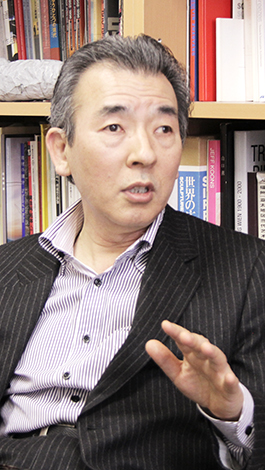
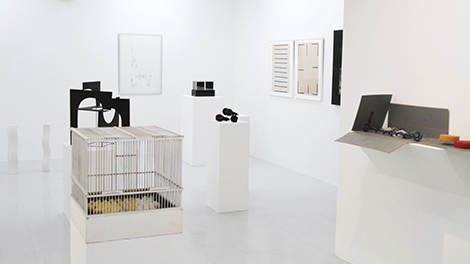
Interior of Tokyo Gallery
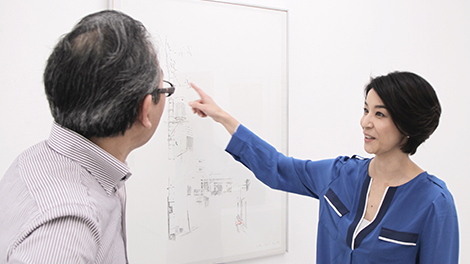
It’s important to expose kids to lots of good music and art.
- Takashima
- Art seems somewhat difficult to decipher. Can you give some tips for appreciating art?
- Yamamoto
- I tell visitors that art is made up of three things: materials, techniques, and concepts. That means, what kind of materials were used? What techniques were used to create it? And, what exactly is the artist trying to say?
- Takashima
- The part about what they are trying to say seems the most difficult. If the viewer cannot catch the meaning of the piece, is that their own fault, or the fault of the piece itself?
- Yamamoto
- Consider this – most Japanese people seeing Mount Fuji think it is beautiful, right? Why do we think so? It’s because we learned to think so. We saw Mount Fuji with our mother and father and they said it is beautiful. That is a type of learning. Art appreciation is always learned, and the viewer’s power of understanding depends on how much they’ve learned.
- Takashima
- I see! It is the same with music. If you play Mozart for aboriginals in Africa, they do not think it’s good at all. You only come to recognize something as music after learning through various experiences.
- Yamamoto
- Exactly. And those experiences are cultivated in the environment. For example, if you brought aborigine children to our home, they would grow up the same way I was. So, it is not inherent skills, but environment that is important. Art is viewed differently after seeing many different pieces and learning about it.
- Takashima
- Very interesting.
- Yamamoto
- That’s why it’s important to expose kids to lots of good music and art. Kids have supple minds, so they soak things up like sponges. I think it would be good to teach kids these sorts of things in school.
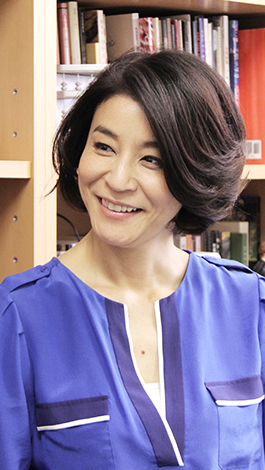
1 2
All List
- GINZA CONNECTIVE VOL.0 Ryo Sayegusa×Chisako Takashima
- GINZA CONNECTIVE VOL.1 Toshiyuki Kosaka×Chisako Takashima
- GINZA CONNECTIVE VOL.2 Yasuharu Mizuhara×Chisako Takashima
- GINZA CONNECTIVE VOL.3 Hitoshi Ishihara×Chisako Takashima
- GINZA CONNECTIVE VOL.4 Shinji Hara×Chisako Takashima
- GINZA CONNECTIVE VOL.5 Choichiro Motoyama×Chisako Takashima
- GINZA CONNECTIVE VOL.6 Noriko Okazoe×Chisako Takashima
- GINZA CONNECTIVE VOL.7 Choichiro Motoyama×Chisako Takashima
- GINZA CONNECTIVE VOL.8 Sayuri Yamaguchi×Chisako Takashima
- GINZA CONNECTIVE VOL.9 Yoshiki Tani×Chisako Takashima
- GINZA CONNECTIVE VOL.10 Yoshifumi Itoh×Chisako Takashima
- GINZA CONNECTIVE VOL.11 Kunihiko Miwa×Chisako Takashima
- GINZA CONNECTIVE VOL.12 Shin Watanabe×Chisako Takashima
- GINZA CONNECTIVE VOL.13 Akihiko Tsuda×Chisako Takashima
- GINZA CONNECTIVE VOL.14 Rie Horikawa×Chisako Takashima
- GINZA CONNECTIVE VOL.15 Jun Takahashi×Chisako Takashima
- GINZA CONNECTIVE VOL.16 Yusuke Harada×Chisako Takashima
- GINZA CONNECTIVE VOL.17 Lintaro Mizuhara×Chisako Takashima
- GINZA CONNECTIVE VOL.18 Keisuke Anzai×Chisako Takashima
- GINZA CONNECTIVE VOL.19 Hozu Yamamoto×Chisako Takashima
- GINZA CONNECTIVE VOL.20 Koji Shibata×Chisako Takashima
- GINZA CONNECTIVE VOL.21 Kayo Hosono×Chisako Takashima
- GINZA CONNECTIVE VOL.22 Mitsuru Saito×Chisako Takashima
- GINZA CONNECTIVE VOL.23 Akihisa Kawaguchi×Chisako Takashima
- GINZA CONNECTIVE VOL.24 Mamoru Sugiyama×Chisako Takashima
- GINZA CONNECTIVE VOL.25 Michiaki Kumagai×Chisako Takashima
- GINZA CONNECTIVE VOL.26 Shinichi Tanizawa×Chisako Takashima
- GINZA CONNECTIVE VOL.27 Koichi Suzuki×Chisako Takashima
- GINZA CONNECTIVE VOL.28 Munehito Matsuzaki×Chisako Takashima
- GINZA CONNECTIVE VOL.29 Hiroshi Hara × Chisako Takashima
- GINZA CONNECTIVE VOL.30 Shigeyuki Ando×Chisako Takashima
- GINZA CONNECTIVE VOL.31 Yukichi Ishikura × Chisako Takashima
- GINZA CONNECTIVE VOL.32 Seiko Yamada × Chisako Takashima
- GINZA CONNECTIVE VOL.33 Mami Nagai × Chisako Takashima
- GINZA CONNECTIVE VOL.34 Ryuta Takahashi × Chisako Takashima
- GINZA CONNECTIVE VOL.35 Kazumasa Osumi×Chisako Takashima
- GINZA CONNECTIVE VOL.36 Masahiro Kameoka×Chisako Takashima
- GINZA CONNECTIVE VOL.37 Shoichiro Watanabe×Chisako Takashima
- GINZA CONNECTIVE VOL.38 Keiji Niimoto×Chisako Takashima
- GINZA CONNECTIVE VOL.39 Chieko Nakamura ×Chisako Takashima
- GINZA CONNECTIVE VOL.40 Atsushi Yamane×Chisako Takashima
- GINZA CONNECTIVE VOL.41 Masaya Shibuya×Chisako Takashima
- GINZA CONNECTIVE VOL.42 Makoto Suzuki×Chisako Takashima
- GINZA CONNECTIVE VOL.43 Masaya Konaka×Chisako Takashima
- GINZA CONNECTIVE VOL.44 Masakazu Tanaka×Chisako Takashima
- GINZA CONNECTIVE VOL.45 Koko Kameoka × Chisako Takashima
- GINZA CONNECTIVE VOL.46 Jin Hirayama×Chisako Takashima
- GINZA CONNECTIVE VOL.47 Takashi Hoshihara×Chisako Takashima
- GINZA CONNECTIVE VOL.48 Mikiko Kimura × Chisako Takashima
- GINZA CONNECTIVE VOL.49 Keisuke Okamoto×Chisako Takashima
- GINZA CONNECTIVE VOL.50 Akira Ito × Chisako Takashima
- GINZA CONNECTIVE VOL.51 Tatsuhiko Adachi × Chisako Takashima
- GINZA CONNECTIVE VOL.52 Masahiko Yamano×Chisako Takashima
- GINZA CONNECTIVE VOL.53 Kiyoshi Kanazashi×Chisako Takashima
- GINZA CONNECTIVE VOL.54 Noriyuki Tsuji×Chisako Takashima
- GINZA CONNECTIVE VOL.55 Shoichi Kobayashi×Chisako Takashima
- GINZA CONNECTIVE VOL.56 Isao Nanjo×Chisako Takashima
- GINZA CONNECTIVE VOL.57 Shinobu Mitsuoka×Chisako Takashima
- GINZA CONNECTIVE VOL.58 Motoyoshi Yasuda×Chisako Takashima
- GINZA CONNECTIVE VOL.59 Toru Fujiki×Chisako Takashima
- GINZA CONNECTIVE VOL.60 Yuji Ida×Chisako Takashima
- GINZA CONNECTIVE VOL.61 Hitoshi Miki×Chisako Takashima
- GINZA CONNECTIVE VOL.62 Takehiko Furuya× Chisako Takashima
- GINZA CONNECTIVE VOL.63 Naoki Yoshizawa×Yusuke Yoshizawa×Chisako Takashima
- GINZA CONNECTIVE VOL.64 Kazuhito Kawase × Chisako Takashima
- GINZA CONNECTIVE VOL.65 Toshiji Yuki× Chisako Takashima
- GINZA CONNECTIVE VOL.66 Hikoyuki Yamaguchi×Chisako Takashima
- GINZA CONNECTIVE VOL.67 Daisuke Nagano×Chisako Takashima
- GINZA CONNECTIVE VOL.68 Shuichi Motohashi× Chisako Takashima
- GINZA CONNECTIVE VOL.69 Shinpei Tonaka×Chisako Takashima
- GINZA CONNECTIVE VOL.70 Shinya Kanematsu × Sachiko Takashima
- GINZA CONNECTIVE VOL.71 Masataka Yano×Chisako Takashima
- GINZA CONNECTIVE VOL.72 Mitsuhiro Kurokawa× Chisako Takashima
- GINZA CONNECTIVE VOL.73 Ryo Saegusa×Chisako Takashima








